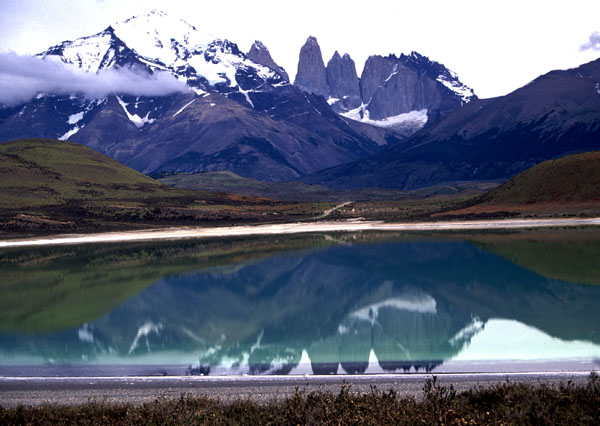
Iron or Plastic

Iron or Plastic
“Are you Iron Man or Plastic Man?” laughed Raoul. He arrived an hour after the others, wheeling his ill-equipped bicycle along the sandy road, wearing a leather jacket, and smoking a chain of cigarettes. “I’m Plastic Man. Him,” he says, pointing to strongly built, non-smoking, Arthur, “he’s Iron Man. When it’s tough, do you wheel or do ride? Are you Plastic Man or Iron Man?” I admit that I’m a bit plastic too, having wheeled some of the way.
The Town
Three days ago I left Puerto Natales. It is one of only two places
larger than a hamlet in Magallanes Region, Chile’s deep south. It
means “Port Christmas”. I arrived there on Christmas Day. It was
only my second Christmas away from my family. Five years before I
spent Christmas in Puerto Natales as well. Christmas is the time
to be here. It is not a pretty town, but with the luminous light
of high latitude and the location, you forgive all. You may be in
Chile, but here you must
look west to see the Andes. They lie, glaciers and all, across
the waters of Seno Última Esperanza (Last Hope Sound), on islands.
The hostel owners were barbecuing Christmas dinner, and for a remarkably small fee the guests could join in. After a couple of hours I refused any more. I had eaten steak, pork, chicken, three kinds of sausage, potatoes and salad. “But we haven’t even started to roast the lamb yet,” they said in astonishment, pointing to an entire carcass. Paula, my host, is a friendly buxom Argentinean who runs three simple wooden houses as hostels with her extended family. Another sheep was still running round the garden. It came from the family sheep farm, a short distance away over the border. It would be barbecued on New Year’s Eve. I promised myself to be back for New Year’s Eve.
A clothes shop advertised the arrival of summer fashions. But every knee and elbow in the town was firmly wrapped up against the cold wind and squally showers. In wind-blown Puerto Natales, knees and elbows stay hidden every day of the year. The tourists huddle next to the heaters in cafés drinking hot chocolate. So what then are the summer fashions in southern Patagonia?
The Cave
I rode off into the wind along a soft gravel road. I was heavily laden with several days’ food, and turned left where the signpost points to the Mylodon Cave. In this enormous cavern was found, over 100 years ago, the fur and bones of an extinct giant ground sloth. The mylodon is now thought to have lived about 10,000 years ago, but at the time such well-preserved remains raised hopes of finding one still alive. There are also traces of prehistoric men in the cave. Since man has been in the area at least 10,000 years, today’s wild sloth chase is to discover whether man and sloth cohabited in the cave. The cave now contains an unbelievably horrible life-size plastic model of a mylodon.
The cave is an enchanted place nonetheless, and I spent a cold but happy hour pottering around in the wind and showers. The entrance is hidden by rocks and groves of twisted southern beech (ñirre). Another sorry sight are the spoil heaps of archaeological investigations, and disappointingly the ‘cave paintings’ are only water stains.
The Back Road
It had rained heavily the previous night. Fresh snow on the hills made up for the dullness in the everyday overcast sky. From time to time the valley ahead pointed directly at my objective, a glimmer of sun on the wild sculpted granite spires of the Cuernos del Paine (Horns of Paine). I had heard cyclists could get through this way, and for the moment I was surprised and grateful for a well maintained, but little used gravel road.
A little while later I climbed over a locked gate, somewhat nervously as I was in full view of the casco (head house) of the estancia (estate) whose logo adorned the ‘Privado’ sign. I found myself on a rough track, getting worse all the time as I forded streams, and pushing the heavy bicycle through loose stones up little hills. But passers-by, two gauchos with a spare horse and three dogs, waved in a friendly manner, and I relaxed.
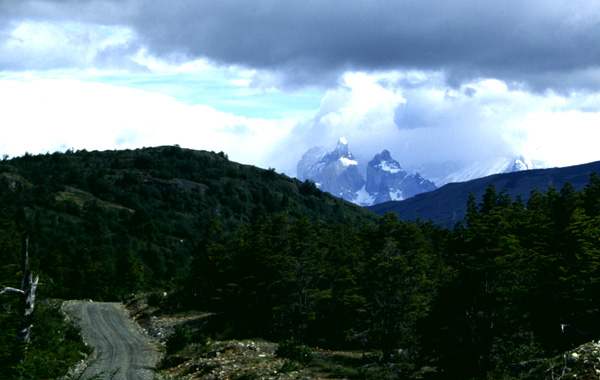
The Back Road
At just the right time in the late afternoon, I found my dream. A sheltered, flat grassy patch by a rushing stream in a beautiful wood is paradise to the wild-camper on a windy day. Suspicious, unbelieving of such good fortune, I stood still on my planned camp spot for what seemed like an age. I was doing the mosquito test. It passed with flying colours. Until, of course, I had got my tent erected and my luggage scattered all over the ground. Then the infernal beasties saw they had me trapped and descended on me in hordes. I could see them landing on my repellent-laden skin. Then I saw them coming back with an “It may taste horrible, but it’s this or I’ll starve” bite. My business of eating was done with undesired haste as I sought to minimise their business of eating. I was forced back inside the tent, however pleasant the evening. But I fell asleep knowing I was in now in the Patagonian paradise I had come to rediscover.
The Bridge
Early in the morning as I cooked my porage and swatted more mosquitoes, the gauchos came by again. Their flock of dogs was now augmented to about a dozen, suggesting in my addled brain a strange reversal of normal farm roles of dog and stock. The morning was fine, and I climbed to a viewpoint above Lago Toro. Ahead of me were not only the great mountains, but the wide, serrated immensity of the Grey Glacier stretching out from the continental ice sheet. I had first seen the glacier five years previously, on a walking tour of Torres del Paine, from the top of a pass, struggling to stand in a gale, and crunching midsummer ice and snow beneath my feet. Up to three miles wide and at such low altitudes, the Patagonian glaciers surpass anything you will see in the Alps, perhaps even the Himalayas.
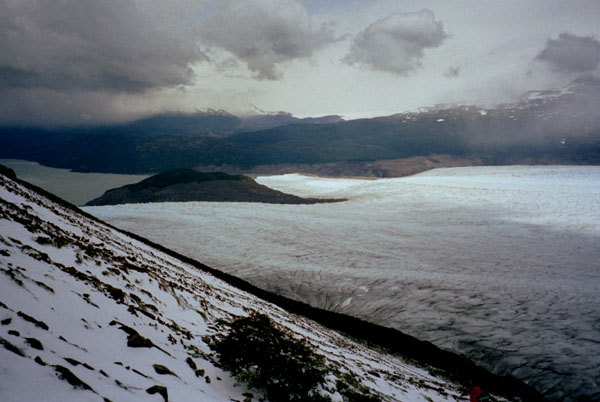
Ventisquero Grey (seen on my previous visit)
The track was slow going, and it was around lunchtime that I approached the Río Serrano. I had heard the bridge was down, but a cyclist could cross. I looked with some concern at the wide, fast-flowing river, at least chest deep. It was well beyond my fording skills. I thought of a gnarly route described in a mad mountain biking book from New Zealand, which advised the rider to inflate his tractor tyre inner tube and float across the river. Then the old bridge came into sight, about 100m long crossing the river via a small island. Three planks’ width, in places only two, hadbeen relaid on the trestles, the old hand-rail staying well out of reach.
Some planks were rotting, some loose, some sloping. At times, the route moved one plank to the left or one plank to the right. I deliberated whether to take the luggage separately from the bike. But we were out of the gale, and I decided that crossing five times was more than I wished to do. So I slowly wheeled the fully laden bicycle across, trying to avoid the dodgier planks. And then I was in the park, and though there was no one in sight I felt rather guilty about my unpaid-for entry.
The Wind
I was on a gravel road again, but it was badly corrugated and the wind was getting up. I came to the hostel where I had passed a night in the park on my last visit, and retrod old view-points and beauty-spots. I looked for the ñandúes (lesser rheas - Patagonian ostriches) which I knew lived on these flats, but today I was disappointed. Finally finding a wind-sheltered spot by Lago Pehoé in the coldly burning sunshine, I ate a late lunch. The Horns of Paine became ever more dominant in the landscape.
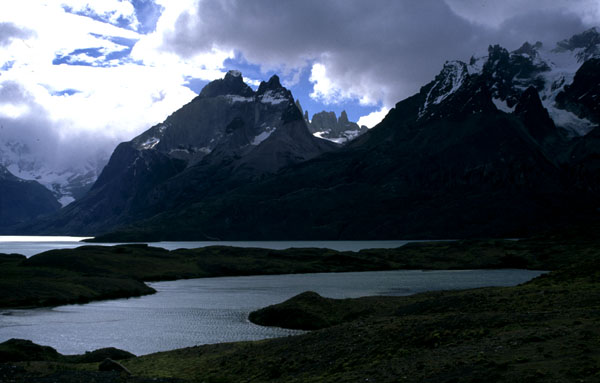
Los Cuernos del Paine
Around three o’clock I came to Camping Pehoé and decided I was tired though I had covered barely 30km. I asked how much it cost to camp. “8,000 pesos for up to five people and a van” said the CONAF (conservation department) employee. That was over £10. More to the point, it was over three times what I paid for a warm bed and hot shower in Puerto Natales. “How much is it for one gringo on a bicycle?” I asked. “It’s 8,000 pesos whether you are one or five, whether you have a bicycle or a camioneta” (pick-up truck) he said. “Is there anyone I can share with?” I said, but he pretended not to hear. He was aware of the injustice of the price but it was moron-his-jobsworth to try to find a way around it. “Is there anywhere more reasonable?” I asked. He told me of a campsite by the Río Serrano, a couple of km from the bridge, that was only 2,000 pesos per person. I wasn’t going back. The same 2,000 peso price is charged at Campamento Torres, which was still 30 or 40km further on. I was not happy about carrying on, as the wind could easily make such a distance unattainable in half a day on these roads, on any roads. Moreover I would not be able to wild camp here in the park.
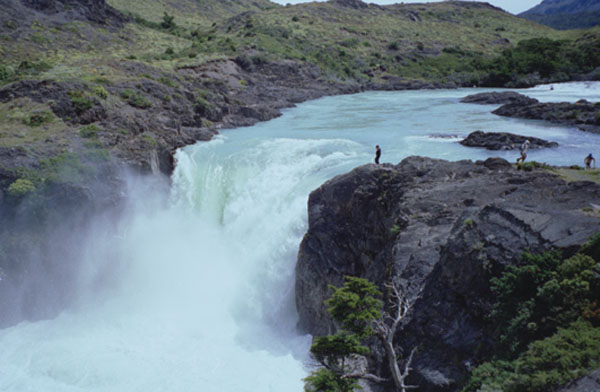
The falls
But I was not prepared to pay such an absurd price for a simple campground with only a cold tap, and my anger reinforced the strength in my legs. Slow progress to the corner of the lake in the strong swirling winds made me wonder whether I had taken the right decision, though the bright sunny intervals and mysterious clouds round the peaks made the journey a rare one for its views. As I passed the great waterfall, the road turned east and I suddenly felt the wind on my back. It pushed me almost dangerously fast on the appallingly eroded surfaced of the over-used gravel tracks of the park. I was in luck.
The People
There is something Irish about this park. Paine is like the Mapudungun
word for light blue. But the Mapuche, whose language it is, live
1000 km north of here. The local natives, now practically extinct,
are the Tehuelche, and they have no such word. Although the Chilenos
say it as they see it written, “pie-nay”, it seems more likely that the
park was named for an Irish explorer of whom all else is forgotten.
Paine, Grey, Dickson, and Nordenskjöld, typical Patagonian names all
of them.
I was being blown up and down over hills along the southern shore of
Lago Nordenskjöld, on some arid steppes which hold a large concentration
of guanacos.
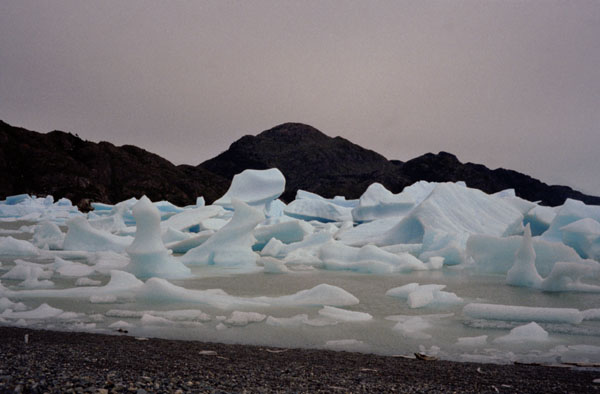
Icebergs in Lago Grey
Such is the effect of the high mountains, that areas of near desert lie close alongside impenetrable rain-forest. The guanaco is the wild ancestor of the domestic llama, and once roamed a continuous area of temperate grasslands from Colombia to Tierra del Fuego, at ever greater altitudes as they approached the equator. Today such undisturbed habitats are rare outside Patagonia. The Tehuelche were guanaco hunters, clothing themselves - to the limited extent that they wore anything at all - in its skins.
The near nakedness of the Patagonian natives in the cold humid climate seems strange to a warmly wrapped modern European. But I recalled that the Ancient Britons and the Picts were noted for baring considerable areas of woad-painted flesh, scarcely more covered than the Racquel Welch of stone-age fantasy. Little more than a hundred years ago, European settlers displaced the guanaco herds with their sheep estancias. The Tehuelche had no option but to hunt the sheep, and became hunted themselves as a consequence. Some were settled into reservations, the ominously named reducciones, where missionaries attempted to teach them the basic technologies of European civilisation. Most of them rapidly succumbed to influenza and mumps. Only an endangered few remain. Unlike other parts of Chile, native genes barely figure in the Patagonian racial mix of Croat and Norwegian, Scot and Galician.
The Wildlife
A tourist bus stopped by a group of guanacos. Some expensively and unsuitably dressed Americans were gee-whizzing with their expensive cameras and camcorders. A pair of turkey vultures rose into the sky, and their guide pointed out the “cóndor, cóndor” to them. Though the vultures are little more than half the size of the real thing, I remember being conned in the same way before, and I felt they had a right to the same illusion I once shared.
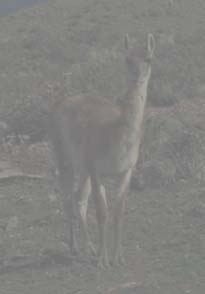
Guanaco
The success of conservation has seen guanaco numbers increase tenfold in but five years, and they are now a common sight. They stand there, as much interested in you as you in them, it seems, holding themselves proud with a hint of the Mona Lisa’s smile. Even more wondrously, the puma population is growing with them, and sightings are becoming more frequent, though still requiring considerable luck. There are also parrots in the woods.
I now had a large descent down into a river valley, and the Towers, the three infamous teeth commemorated in the name of the park came into view. I had no idea it was even possible to see them from here, on the road, for most days such views are hidden in the overcast skies. Nor could I have dreamed on the impossibly picturesque views of the sun gleaming on the meanders of the river and lighting lenticular clouds in the sky. It was life turned into a dream.
The Towers
The last 7km on a loose sandy track took a full tired hour. It was approaching eight when I arrived at Campamento Las Torres. The towers were indeed hanging over this flat plain dotted with occasional ñirre trees. It was not quite lonely wilderness, but I was grateful for a hot, gas-fired shower and water from a tap rather than the trickle of a near dried-up stream. Camping nearby was a rare English voice. Vaughan was eating cake with dulce de leche, the local fudge spread made from boiling up creamy milk and sugar. In every day life he was a site supervisor on the Second Severn Crossing. Few people realise that on such a project a chartered engineer will earn less than the navvies he supervises. We agreed to get up before the crowds for a climb up to the base of the towers.
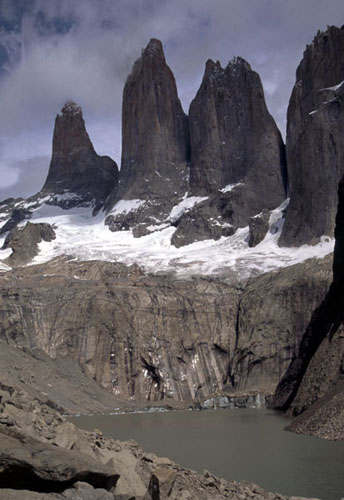
Las Torres del Paine
We enjoyed stunning sunshine for our walk. We also made a detour to visit the climbing camps in the adjacent valley, from where the mad mountaineers would attempt their conquests. They need several days of good weather to make an ascent, as each tower offers around 5000 feet of technical climbing. Good days are a rare treat in a normal year. It is not unusual to spend months waiting for enough good days. But the El Niño weather system this year would provide ideal conditions, though later it would also supply death-dealing floods. Climbers must take special precautions in Patagonia. So strong are the winds that ropes cannot be left on the rock overnight, or they will be frayed through by the morning. Verglas, a thin layer of slippery ice rime covering the rocks, is another local hazard. Some local peaks, such as Paine Grande, have hongos, literally mushrooms, meaning overhanging ice-caps. Massive blocks can fall down the face onto unfortunate climbers below.
Iron Men
And in the evening the cyclists started to arrive. First came Ignace, a young Belgian, with Arthur and Martin, both Swiss. An hour later came the German Raoul, cigarette in his mouth, leather jacket, cheap bicycle hand-painted fluorescent green. They had come the same way as me, but half a day behind.
Raoul explained to me why Arthur is Iron Man. Arthur took part in the Iron Man triathlon on Hawaii, achieving in eight hours what the winner did in seven, a highly creditable performance. He had also cycled the road cyclists fear, Ruta 40. This is the unpaved road which follows the Andes down the west side of Argentinean Patagonia. If you set out you have to finish, for there are no buses and not even hitches to be had. The locals say that not even the birds fly that way. It frightened me for the few and uncertain sources of water. “There is water at least every 150km,” said Arthur, as though that reassured. “You will never forget riding it,” he said, “but I wouldn’t do it again. There is so little to see.”
Martin was also Iron Man, according to Raoul, as he showed us on the map of South America all the remote wildernesses and high altitude deserts he wished to cycle across. His first plan was an illegal border crossing for a short-cut to the Moreno Glacier in Argentina. The risk was that he would then have to find another illegal crossing before anyone checked his passport. But he admitted to a degree of plasticity. Following Ruta 3 down the east coast of Patagonia, he gave up and hitched. This is the easier alternative to Ruta 40. Although Ruta 3 is flat, paved and has towns at 200km intervals, the extraordinary winds and complete absence of a view make it a physical and mental challenge. Martin ran out of water. A couple of months later I would have to choose between Ruta 3 and Ruta 40 going north. I chose the overnight bus.
Plastic Men
But Raoul - Raoul is Plastic Man. When the wind starts to blow, then Raoul starts to push. He had just cycled across Tierra del Fuego where the wind it does blow even stronger than here. He pushed his bike for 50km at one point. Raoul thought that Plastic Man has better fun than Iron Man, because he gets to meet Barbie Girl, but Iron Man meets Mrs Thatcher. Here in the park we were temporarily spared the sound of the Barbie Girl Song, Number One that Christmas.
A Belgian student in real life, Ignace is also Plastic Man. A week later I heard a report of two cyclists on a flat, paved road in the desert, out of water, and pushing their bikes in the wind. Plastic Men. Only Raoul and Ignace could fit the description. They made the mistake of thinking that a name on a map meant there was something there. So they had not carried enough water. They were probably only 50km from the town of Calafate. But that is no consolation with a Patagonian gale in your face so strong that you must walk on a flat, paved road.
Ignace was young, tall and strong, with the long blond hair so favoured in this part of the world. He was having luck with the chicas. But he was ruing the fact that the luck was no good to him. He met three attractive Belgian girls on their way to the nearby CONAF-run hostel, and by chance he vaguely knew one of them. They wanted to have dinner with him at the hostel. But the extortionate park price was way beyond his over-spent budget. Ignace’s tent was little more than a bivouac, hardly room for one in my view. Less blessed in youth, figure and hair, the other cyclists reminded him of these little shames as frequently as they could. No budget, no room, no chicas...
The Barbecue
It was New Year’s Eve and I had an appointment with a sheep. There was 115 unpaved km back on the main road to Puerto Natales. Not such a rough or hilly route as I had come, but it could be a long way on any road in this part of the world. I was tempted to stay here and have New Year with the cyclists, rather than risk a solitary New Year half way back. Arthur, confident it would only take him a day offered to ride with me. He had to catch the boat and he had to make it back. For the day I was Iron Man too, keeping his pace, and even losing him for a while. We covered it in 11 hours.
And the winds were not good. But Paula’s lamb barbecue was excellent.
Afternote
Marc, the French cyclist mentioned in my article “Gringo in the Monte”, also met Ignace. It was six months later and Ignace had cycled the whole way to Perú. Not so plastic after all. Marc and Ignace cycled together for several days. Ignace was still having problems with his budget.
Ivan Viehoff, August 2001
